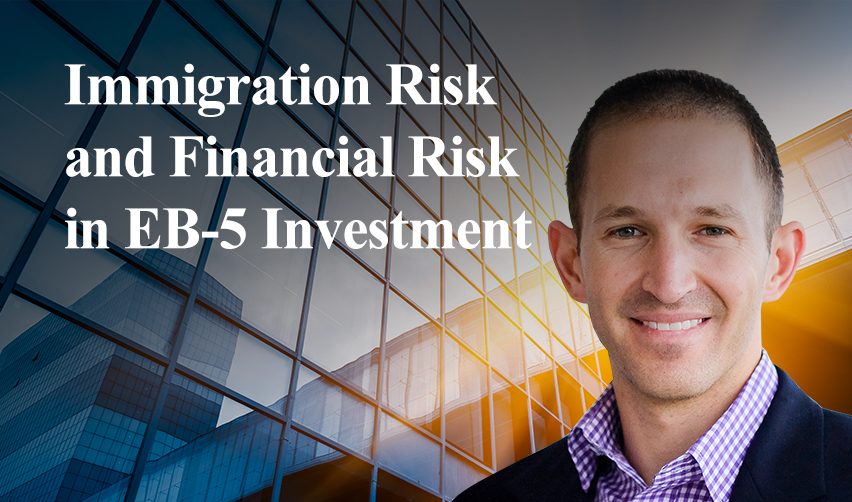No EB-5 investment is without risk. While different types of projects have different risk profiles, the risk to EB-5 investors can be generally broken into two distinct categories of risk: immigration risk and financial risk.
These two types of risk reflect the top two goals of investors in EB-5 projects. First, EB-5 investors invest in EB-5 projects primarily for purposes of immigrating to the United States, and so the first category of EB-5 risk is related to immigration. Second, since EB-5 investors are investing large sums of money, they want to keep their money safe, and so the second category of EB-5 risk is related to the investors’ financial investment.
EB-5 investors must carefully consider how much immigration and financial risk any given EB-5 project exposes them to. Investors should avoid any project with either high immigration risk or high financial risk. Low-risk projects are available, and EB-5 investors should be selective.
Immigration Risk
Immigration risk involves anything that might prevent an investor from achieving his or her ultimate goal of obtaining a permanent green card and becoming a lawful permanent resident of the United States.
Reducing immigration risk involves addressing the primary reasons EB-5 immigrant petitions are denied. EB-5 investors face individual risk based on their petition’s accuracy and their personal history. United States Citizenship and Immigration Services (USCIS) will deny petitions for fraud, misrepresentations, unlawful sources of EB-5 investment funds, and similar deficiencies specific to an investor. EB-5 investors should carefully select immigration counsel to limit this kind of personal risk.
For investors applying in good faith who have clean histories and lawfully obtained funds, the main causes of EB-5 immigrant petition denials are caused by some deficiency in regional center compliance or problems with the project—especially insufficient job creation.
EB-5 Compliance
USCIS requires strict adherence to the rules of the EB-5 program. EB-5 regulations have always been somewhat complicated and setting up a project to receive EB-5 investment requires specialized knowledge. With the recent passage of the EB-5 Reform and Integrity Act of 2022, the need is even greater for an experienced and knowledgeable regional center sponsor to ensure EB-5 compliance.
To limit immigration risk as much as possible, EB-5 investors should seek projects with independent, third-party regional centers not affiliated with the project developer. The regional center operator should be experienced and have a history of compliance with all EB-5 program requirements. Accountability is vital to trust, and investors should pursue projects whose regional centers offer regular reporting and take pride in transparency.
Job Creation
EB-5 immigration risk is closely tied to job creation. The purpose of the EB-5 program is to generate economic development in the United States, especially in rural locations and in areas of higher-than-average unemployment. The EB-5 program measures economic development in dollars—there is a minimum required investment amount—and through job creation.
To qualify for permanent resident status, investors must invest at least $800,000 in a project located within a targeted employment area (TEA) or $1,050,000 in a project outside a TEA. Basically, a location qualifies as a TEA if it is rural or is experiencing high unemployment rates.
In addition to a minimum investment amount, the EB-5 program requires each investor’s investment to result in the creation of at least 10 full-time, permanent jobs for U.S. workers. For projects sponsored by regional centers, these jobs can be calculated using economic models and may include jobs directly created by the project and jobs created as a result of the increased economic activity in the area.
EB-5 investors should avoid projects that predict they will create just enough jobs to satisfy the 10-jobs-per-investor requirement of the EB-5 program. The more additional jobs expected to be created, the better.
Under EB-5 program rules, investors are allowed to invest in projects that have already created jobs. The safest projects, then, are those that have already created more than enough jobs to accommodate all potential EB-5 investors.
Financial Risk
Financial risk involves anything that might threaten the full repayment of the capital invested by an EB-5 investor into an EB-5 project.
Reducing financial risk involves addressing the primary concern of any investment: Will the developer successfully complete the project, achieve financial success, and return all invested funds?
Some EB-5 projects rely on EB-5 funding and are unlikely to succeed unless a minimum amount of EB-5 capital is invested. These projects have not identified capital sources to cover all project costs and may never obtain the financing they need to move forward. Such projects present EB-5 investors with significant immigration and financial risk because failure to complete the project as planned may result in insufficient job creation and will likely result in the partial or total loss of EB-5 investor funds.
The EB-5 projects with the least financial risk are those that have already identified sufficient sources of capital to complete project development and/or operations and are not dependent on raising EB-5 funds to succeed. In such projects, EB-5 capital is simply a replacement for more expensive financing.
Select Low-Risk Projects
EB-5 investors should carefully assess projects and select only those projects that offer excellent regional center compliance, have already created enough jobs for the maximum number of EB-5 investors, and are not reliant on EB-5 capital to succeed.
EB5AN is pleased to offer several such projects.
For more information on EB5AN’s best-in-class, low-risk EB-5 projects, please schedule a one-on-one call with EB5AN or send an email to info@EB5AN.com.







